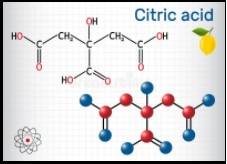What is Citric Acid?
Jabir Ibn Hayyan (Geber) was the first Islamic chemist to discover citric acid. In 1784, Swedish chemist Carl Wilhelm Scheele separated it in crystalline form from lemon juice. While in citrus fruits, it occurs naturally. Citric acid is one of the most popular food preservatives and flavouring additives in the food industry. It can be found in citrus fruit naturally but is also processed. Citric acid is a weak organic acid, having the molecular formula C6H8O7.
The power of A. Niger was first recognised by James Currie in 1917 to manufacture citric acid and development at the industrial level started two years later by Pfizer.
What are the uses of Citric Acid?
In food processing, citric acid has many applications. It is a preservative, a taste enhancer, and helps promote the process of ripening. About 50 % of the world's citric acid production is used in drinks as a flavour booster, and citric acid is manufactured in a powder form when a sour flavour is needed. It is added to dry foods such as seasoning salts, flavouring powders, and crunchy snacks. As a food preservative, the acidic pH of citric acid makes it beneficial. It retains the colour of the food as it greatly slows oxidation. While many bacteria cannot thrive in an acidic environment, as a means of preservation, citric acid is frequently applied to jams, jellies, sweets, and canned foods. Citric acid is often used when making cheese to promote the ripening process.
What are the important things to remember?
Ascorbic acid and citric acid is found in a lot of fruits and vegetables. Because of their similar names and origin, they are often confused with each other.
In the 11th class exam, this topic has a weightage of 3 marks.
Illustrative Examples
- Citric acid is most abundant in lemons and limes among fruits, containing as much as 8 percent of the weight of dry fruit.
- Including lemons, limes, pineapples, grapefruit, grapes, strawberries, broccoli, carrots, and certain types of plants, citric acid occurs naturally.
- Citric Acid is one of the most easily detectable acids in coffee.
FAQs on Citric Acid
Q: How many elements are there in citric acid?
Q: Is citric acid the same as vitamin C?
Q: What are the components of citric acid?
Q: How to clean a toilet with citric acid?
Q: What does citric acid kill?
News & Updates
Acids, Bases and Salts Exam
Student Forum
Popular Courses After 12th
Exams: BHU UET | KUK Entrance Exam | JMI Entrance Exam
Bachelor of Design in Animation (BDes)
Exams: UCEED | NIFT Entrance Exam | NID Entrance Exam
BA LLB (Bachelor of Arts + Bachelor of Laws)
Exams: CLAT | AILET | LSAT India
Bachelor of Journalism & Mass Communication (BJMC)
Exams: LUACMAT | SRMHCAT | GD Goenka Test


